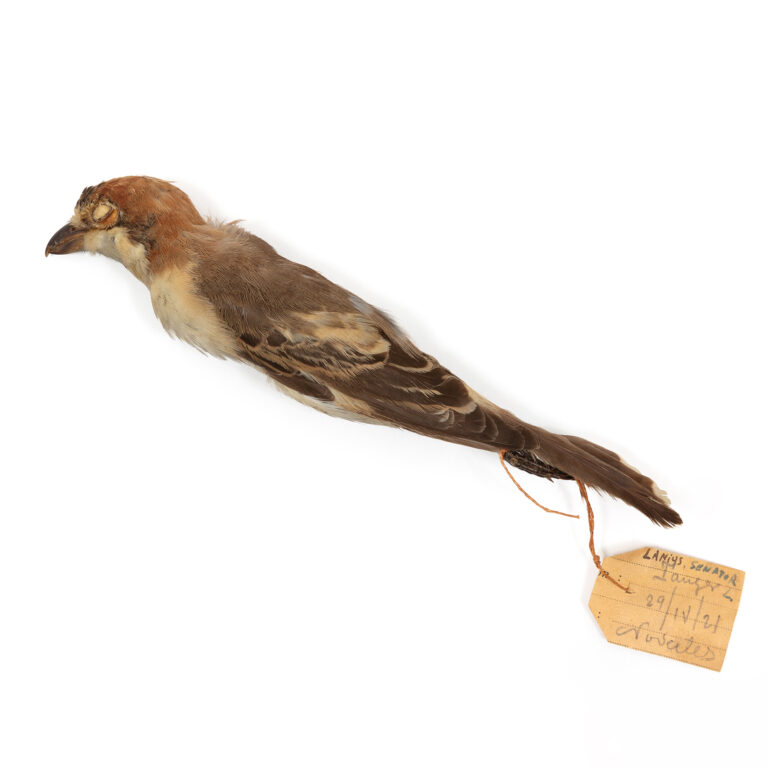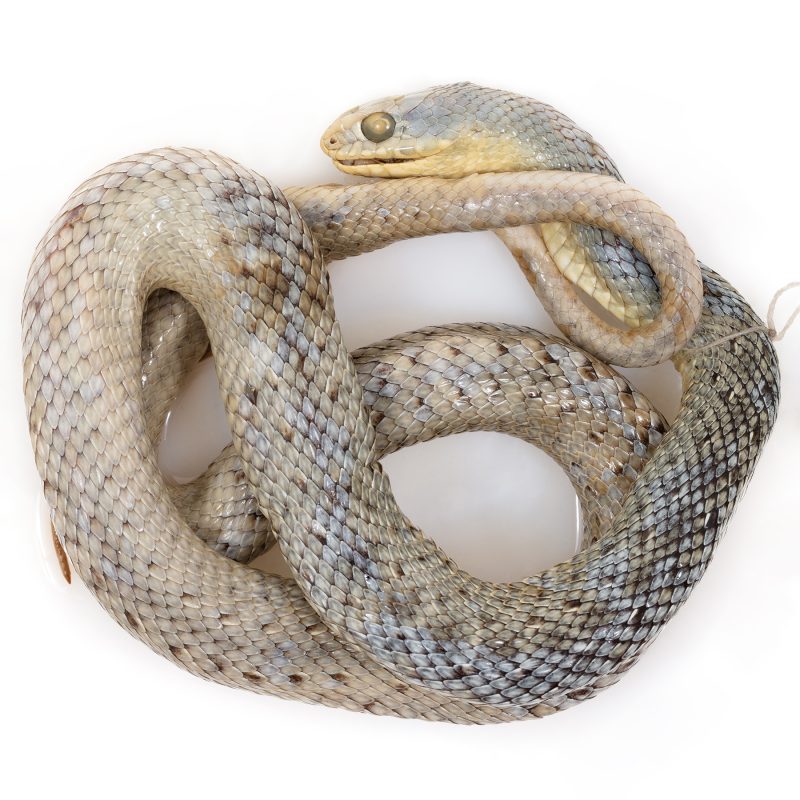Summary of results
This Woodchat Shrike was collected by Santiago Novellas i Bofill in Tangier on 29 April 1921. It has not been possible to cross-reference the data relating to the specimen and the dossiers in the archives of the Natural Sciences Museum.
Chronological reconstruction of provenance
No further specific information about this expedition has been found in these dossiers. We know that Santiago Novellas was a collector for the museum between 1918 and 1925, mainly in Catalonia, but also in Morocco and Mallorca. In 1920, he was proposed as a member of the Catalan Institute of Natural History.
In the database provided by the museum, all the chordate specimens collected by Novellas in Morocco are dated 1921. This shrike is one of sixty-six chordate animals collected between 20 April and 15 May 1921. Most of the specimens are from Tangier, but there are also some from Tétouan and Chefchaouen. After Joan Baptista Aguilar-Amat’s group, which represents 26% of the museum’s Moroccan collection, Novellas’ group is the lot with the most specimens, with 24%.
The 1921 expedition organized by the Natural Sciences Museum was led by Ascensi Codina and Santiago Novellas participated as an assistant entomologist. Ascensi was an entomologist and had a special interest in Moroccan hymenoptera, so the expedition focused, above all, on collecting insects. The main destinations of the trip were Chefchaouen and Tétouan, and so far, no further information has been found on the routes taken by the scientists. What we do know, however, is that Codina accompanied Carles Pau i Espanyol—who was doing herborization in Morocco financed by the Royal Spanish Society of Natural History—on an excursion to Yebala.
The mammals of the Codina-Novellas expedition were studied by Joan Baptista Aguilar-Amat and, as a result, in 1923, this zoologist published the determinations of a dozen mammals captured in that campaign.
The expedition was carried out under the conditions of pressure caused by the instability in Yebala and Gomara, the closest regions to Tangier. There, the initiatives of the Sherif Ahmed ibn Muhammad ibn Abdallah al-Raisuni, known as ‘Al-Raisuni’, had led to Spanish military interventions on the ground. We doubt that, under these conditions, the expeditionaries would have been able to reach Chefchaouen, so we are inclined to think that the specimens were collected in the area near Tangier or Tétouan.
Estimation of provenance
Tangier, 29/04/1921
Possible alternative classifications
–
Complementary sources
Archives:
Id1417 > Certificats conforme Aguilar-Amat i Santiago Novellas són naturalistes del Museu de Ciències Naturals; nomenament d’Aguilar-Amat com a bibliotecari.
Id1585 > Instruccions donades a l’administrador de Correus de Monte Arruit sobre les trameses d’exemplars.
Id1586 > Sol·licitud de finançament per als passatges de l’expedició científica a la zona espanyola del Marroc i comunicació al general governador de Melilla perquè n’estigui informat i autoritzi els treballs, llistat de mamífers extra-catalans de la col·lecció mastològica del Museu de Martorell.
Bibliography:
Aguilar-Amat i Banús, Joan Baptista (1923). Notes mastològiques V: Mamífers d’una excursió al Marroc. Butlletí de la Institució Catalana d’Història Natural, 23(3-4), 64-65. <https://raco.cat/index.php/ButlletiICHN/article/view/19409/313947>.
Butlletí de la Institució Catalana d’Història Natural (3a època, abril de 1920). Any III, (4). <https://publicacions.iec.cat/repository/pdf/00000137/00000037.pdf>.
Fontenla, S. (2017). La guerra de Marruecos (1907-1927). Madrid: La Esfera de los Libros.
González Bueno, A. (2004). Entre balas y lodos: El trabajo de los naturalistas españoles en el norte de Marruecos (1909-1927). Dins H. de Felipe, L. López-Ocón i M.
Marín (ed.), Ángel Cabrera: Ciencia y proyecto colonial en Marruecos (p. 27-45). Estudios árabes e islámicos: Monografías, 7. Madrid: CSIC.
González Bueno, A. i Gomis Blanco, A. (2007). Los territorios olvidados: Estudio histórico y diccionario de naturalistas españoles en el África hispana (1860-1936). Madrid: Doce Calles.
Macías Fernández, D. (2015). Las campañas de Marruecos (1909-1927). Revista Universitaria de Historia Militar, 2(3), 58-71.
Madariaga, R. M. (2005). En el Barranco del Lobo. Las guerras de Marruecos. Madrid: Alianza.
Memorias de la Real Sociedad Española de Historia Natural (1924). T. XII, memòria 5a: 263-401.
Navás, S. J. L. (1922). Insectos de la excursión de D. Ascensio Codina a Marruecos. Treballs del Museu de Ciències Naturals de Barcelona, IV(4), 118-127.



